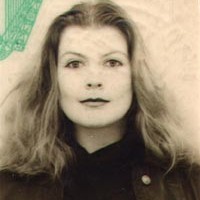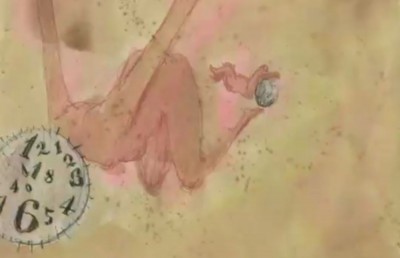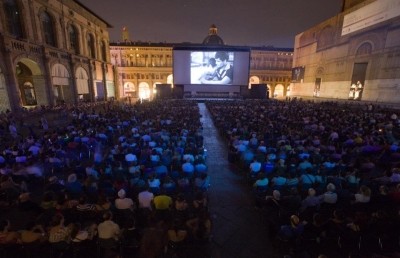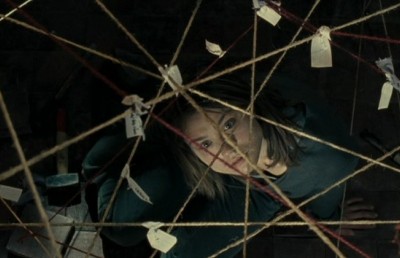Out of Time: The Costumes of Bad Timing (1980)
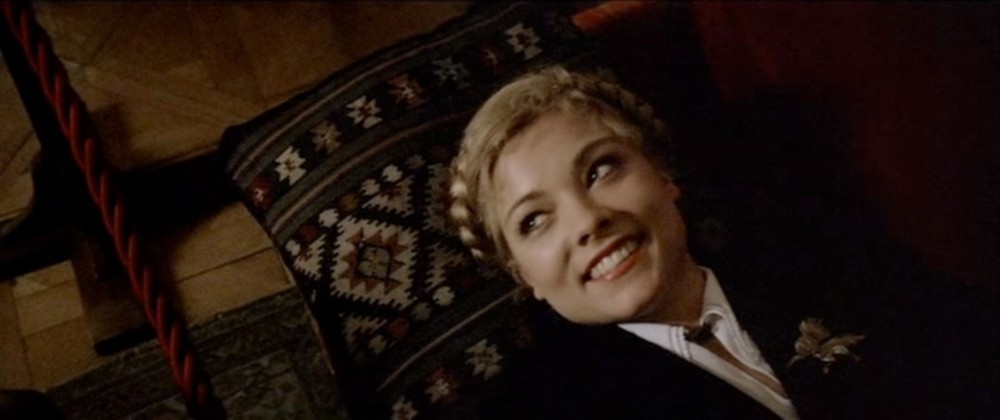
Costume is one of the most underrated components in the panoply of cinematic language. It conveys and conceals physique and character; it portrays ambition and fear, narcissism, exhibitionism, humour and danger; it denudes and covers up, revealing and concealing; it speaks to the audience in a way the character cannot, either verbally or physically. It clashes with or complements the setting. It breaks the fourth wall. It is semaphore to the audience and an essential component of a film’s mise-en-scène.
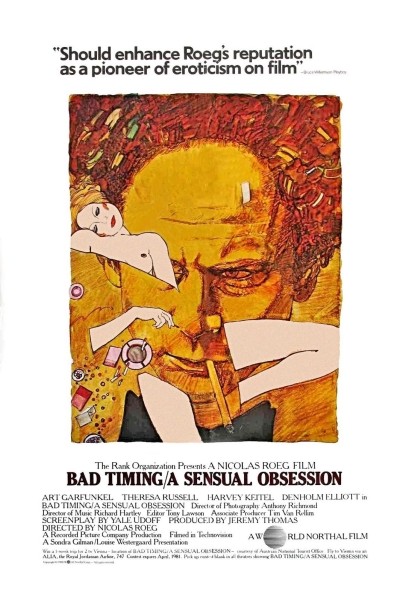
A shroud of darkness envelops the conflict that dominates Bad Timing (1980). Nicolas Roeg’s masterpiece from a screenplay by Yale Udoff – and the most controversial film of his career– signals its polarities in the title sequence at Vienna’s Kunsthistorisches Museum by following American ex-patriates Milena O’Flaherty (Theresa Russell) and Alex Linden (Art Garfunkel) through the display of Gustav Klimt and Egon Schiele paintings. The paintings by Klimt are renowned for their jewel-like colours and scenes of erotic intimacy between lovers. They herald an upcoming romance between the stars and the tenderness is reflected in the way Russell and Garfunkel are shot in silhouette, in thrall to the rapture. The mosaic-like patterns of the paintings also express the way in which time is put together by Roeg’s intricate editing, a maelstrom of emotional and dramatic logic rather than chronology.
The works by Schiele are altogether more disturbing and a portent of things to come. Alex will later be physically likened to one of Schiele’s self-portraits when a postcard from the museum falls out of a book opened by the detective Netusil. The clothes worn by Milena, the film’s protagonist, signal the conflicting discourse her way of life represents in opposition to the supposed normality of psychiatrist Alex, whose grey professional demeanour harks back to an earlier time, perhaps that of The Man In the Gray Flannel Suit (Johnson, 1956), when conformity masked deep-seated subversion, unhappiness and secrecy. The design by Marit Allen, who worked several times with director Roeg, was never more astonishing than here.
This is ultimately a mesmerising mosaic of mistaken identity that oscillates on a spectrum of misunderstanding signified by the film’s elemental mise-en-scène, an act of memory and occasional guilt. It is a story told through art and costume of a woman in crisis.
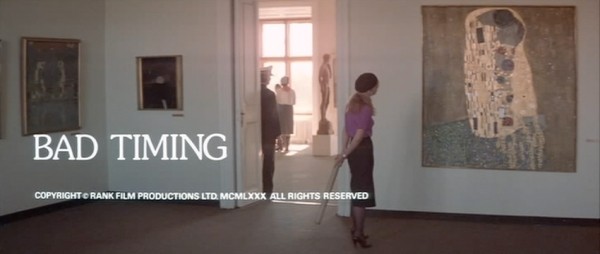
Milena is wearing a blouse in a colour that comes to occupy a significant place in the dramatic unfolding of events between them, violet, and a black beret and tight, A-line skirt. When we first see her she is admiring Klimt’s painting ‘The Kiss’ (above), with a wrapped museum poster held behind her back. She is totally engrossed by the emotionality of the moment. The music by Tom Waits (‘Invitation to the Blues’) enraptures us, telling us a story of a girl who meets a boy in a cinematic dream, in a Hollywood drugstore, Schwabs’, fabled for its Cinderella-like encounters. However we deduce from the title that all will not end well and we are thrust into a story told in different time registers, as Milena is resuscitated in a hospital where she has her stomach pumped and Alex is questioned by an investigator for the Viennese metropolitan police, Netusil (Harvey Keitel) who wonders how a lovely young girl could end up doing this to herself. His question hinges on locating the precise time at which Alex called for help, and when the late night radio station stopped broadcasting. The metaphysics of Milena and Alex’s relationship also depend on their own catastrophic sense of time.
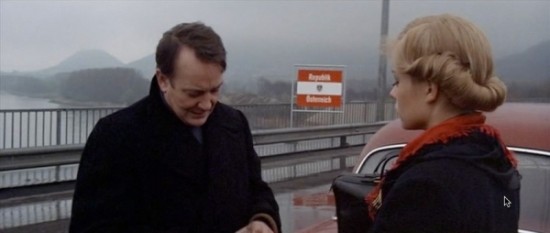
An actual bridge constitutes Milena’s official parting from her ex-husband Stefan (Denholm Elliott), the Czech who comes to interest US military intelligence. They play tug of war with her engagement ring; he adjusts the brooch on her coat collar – it’s a woman’s hand, pointed downwards, with a turquoise engagement ring and matching bracelet. Milena’s hair is in a roll, a tight style that seems to suggest her fixed purpose and a degree of convention, a Mitteleuropäischer Hausfrau, perhaps. The nail polish on the brooch is scarlet, like Milena’s scarf. The wedding ring remains attached to the brooch – just as Milena takes hers back from Stefan. We realise straight away that Milena’s costume directly expresses her feelings and her role in the narrative. She wants to keep her wedding ring. Appearances matter.
Stefan adjusts the brooch on Milena’s collar, the brooch which emblemises their relationship but which she is now escaping. Despite appearances, she is now escaping convention and is set to live a new life on her terms, unmarried and flagrantly available.
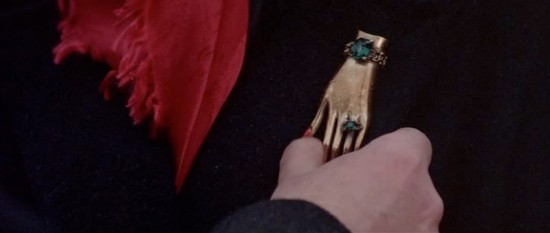
“If we’re gonna meet, it might as well be now.”
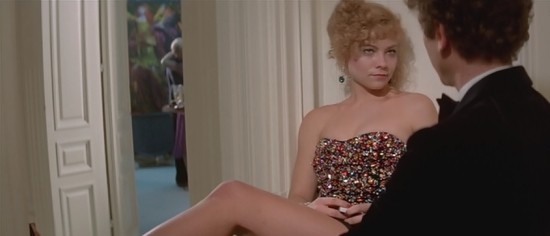
When Milena and Alex encounter each other for the first time it’s at a party at a mutual friend’s. Milena’s elaborate hairstyle, curled and tied off to one side, her highly decorative rainbow coloured jewel-like bodice is complemented by emerald drop earrings and slit skirt. She plays with a bobby pin in her fingers, he taps his with a nail file – an important visual match because he will later rip her clothes apart when he ravishes her comatose body using the same file. Her leg forms a bridge that Alex must approach, one way or another, if he wants to proceed. Bridges and crossing places form a constant visual correlative to the endless obstacles their relationship endures. The encounter is a preview of coming attractions: a positive rainbow of possibilities – all Milena’s colours are on display, a deliberate echo of Klimt’s characters enveloped in a bejewelled bedthrow in the opening sequence. Milena hands Alex a matchbook with her number on it: it’s a replica of a playing card, the Ace of Hearts. The stage is set.
“Take me to your favourite place in Vienna”
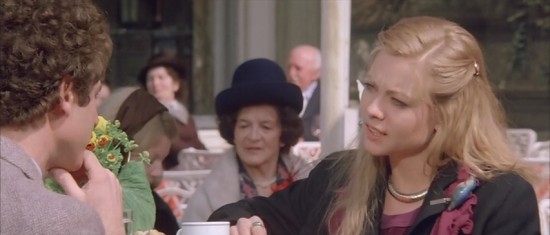
Milena sits at an outdoor café with her hair long, pinned simply at the side, costumed in a dark blazer and fuchsia top with a bluebird brooch and a heavy silver neckpiece over a white tee shirt. She evades Alex’s probing questions. The bird links her flightiness with her explicit character as well as providing a visual match to her outfit in the following scene.
The Lüscher Colour Test (this is not a parlour game)
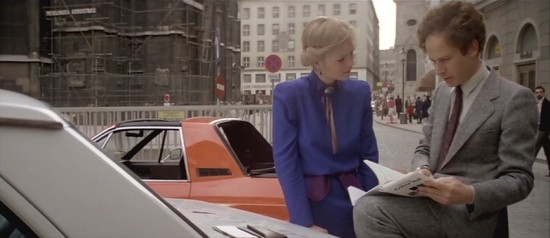
Milena has her hair tied up in a braids wound around the nape of her neck, the front of which is also bound, in collars brought together by a jewelled cornflower blue brooch to match her low-cut dress. She quickly chooses her favourite colours for Alex and turns them up on the boot of his orange car revealing a ring on the index finger of her right hand. She chooses the colours in the order red, yellow, dark grey, purple, orange, dark brown, camel and finally pale grey. Alex tut-tuts at her swiftness and concludes she’s in trouble. They appear to be in a happy place but Milena is really playing dress-up.
“The lineaments of gratified desire”
Milena is clad in a simple blush-coloured nightie while Alex reads her poetry. Her bedroom attire is closely aligned with the colour of her skin and the role of the costume in the film’s fetishistic display is overtly expressed when she summons Alex to the bathroom, finger curled, holding a faux hand in the same, beckoning him and laughing, “Come here Alex, I want to try something!”
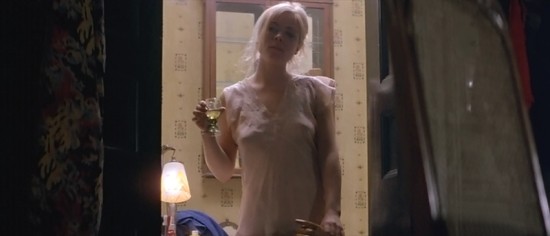
“Definitely happy. At least I hope so.”
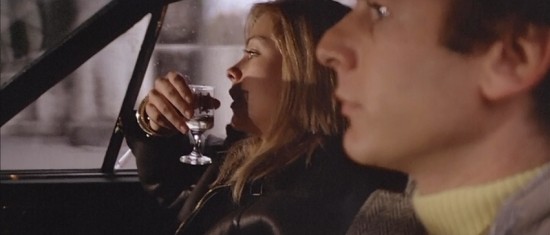
Cutting from the title sequence again when Milena and Alex attempt to interpret the emotional state of Klimt’s subjects, we see Milena dishevelled and drunk and wearing what looks like a man’s leather jacket in Alex’s sports car. She admits to him that she’s had two abortions. In the café where Alex is disgusted by her louche friends, Milena tears off the jacket to reveal a black sweatshirt embossed with an eagle motif and a studded neck. It’s an image of power intended to convey her need for freedom. Her wrists are covered in narrow gold snake bangles, a presaging of things to come.
The Patient
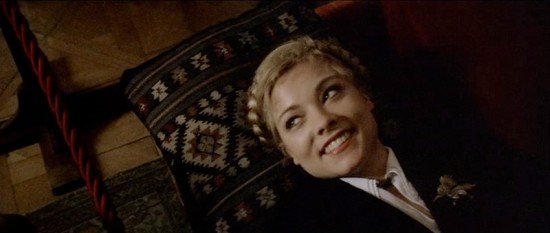
Milena plays at being Alex’s patient and takes to the couch in the Freud Museum, hair braided Aryan-style, literally a buttoned up personality in a black skirt suit with white blouse and one of her ever-present brooches which is a bird, hinting at the ruptures to come. She appears to be the incarnation of a Hitlerian folk dream. Ironically it is Alex who bears the Germanic mark – his surname reminds us of course of ‘Unter Den Linden,’ the famous Berlin boulevard. He is a creature of the city. Milena seems to be something uncultivated, wild, a bird not quite tamed and of more exotic provenance. She is trying on characters for size. Today, she presents herself as his analysand but wraps him in a wild embrace, quite unsuitable for the sober surrounds of Dr Freud’s office yet briefly and humorously appropriating the persona of the classic hysteric, one of his signature findings. The story demonstrates one idea, that of female submission; while the costume indicates the bird struggling to break free of Alex’s cage. This is not a study of transformation, it is a story of desire. Milena is Alex’s muse but she refuses his Pygmalion-like makeover.
“Why can’t we get it back to how it was in the beginning?”
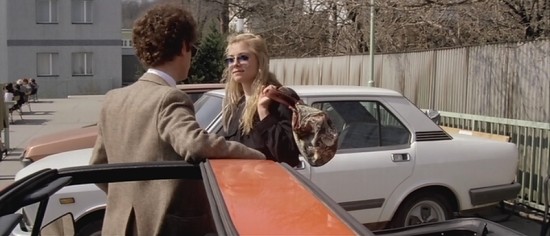
Skipping forward to the first serious signs of cracks in the relationship, Milena decides not to move in with Alex. They are sitting in his car again, she is sporting sober clothes to indicate the situation: short black jacket over a pale grey blouse and high-waisted trousers with tinted oversized blue shades and silver earrings. It is probably the ‘straightest’ outfit in the film and an unconscious echo of his uniformed appearance. Milena gets out of the car and says she’ll take the bus.
In the nightclub during the sex act Milena is wearing a vivid red dress belted with gold mesh when we return to one of their happier times. Alex watches her from a distance with her wild friends, her hair is loose and she is free and in her element. He is set apart by his sober dress and his condescending attitude. She rushes up to him and embraces him with wild enthusiasm.
View from a Bridge
Contemplating their relationship from a bridge, Alex sees Milena’s image in the water, recalling a moment (which we have yet to see) in his office at the Freud Museum when Milena opens her arms to him. She is wearing a red beaded necklace, a red velvet top and scarlet lips. Her nails blaze red like talons as her arms enfold him and her hair is ‘set’ in an old-fashioned hausfrau style which it is clear is Alex’s vision of Milena, not ours. Or hers. She could be his mother.
Parrot
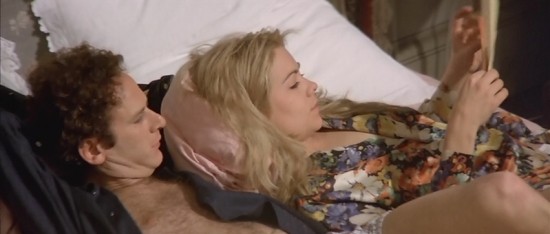
In bed at her apartment Milena is wearing a riot of colour on her dressing gown, a wild array of colours predominated by orange, in a bed of black. The colours are in stark contrast with her mood, which is despondent. It is a pictorial denial of the rapture in The Kiss.
“Some Day I’ll Get Over You”
Cutting to her breakup and final sexual intercourse with Stefan, she is wearing a simple white dressing gown but drying her hair with an orange towel, a colour that links her with Alex (through the sports car) and the wilder life she now embarks upon.
“Where are you going?” “Nowhere!”
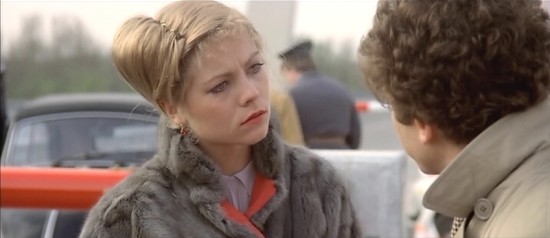
Milena has left Stefan for Alex and is moving in with him but she’s a day late and he’s angry. He is also suspicious of the man who drove her to the border crossing with Bratislava. He is not impressed with her pretty outfit of faux rabbit fur jacket over a coral skirt and red shoes, belt, gloves and purse. She goes back to Bratislava, her hair as tightly wound as Alex’s character. Borders and bridges constitute a highly significant dramatic role in the narrative – a place of transition (in-between-ness) that means going forward into the future – or backwards into the past. They connote separation as well as unity. The time register constantly shifts to give a more accurate emotional index of personal experience. Alex’s portentous view of the world – “to be in between is to be nowhere” – is actualised in these scenes, forcing Milena to be decisive, something which she was not born to be. This is a replay – and a re-imagining of the costumes – of the first scene in which we see Milena at a crossing, but this time Stefan is no longer anywhere to be seen. Milena has literally lost her bearings in a relationship which is tighter than her marriage and is constantly analytical. She is the embodiment of spontaneity to Alex’s careful planning and she suffers under his withering gaze. She is clad in faux-fur, overtly linking her to the world of animals, while Alex typically wears a trench coat over a grey suit. The lining of her jacket echoes the red-orange of the barriers on the border crossing, hinting at difficulties that are made explicit in the scene: she wasn’t on time. There is a barrier between them. It is emblematic of the film’s theme which is constantly exposed in Roeg’s careful composition.
Display
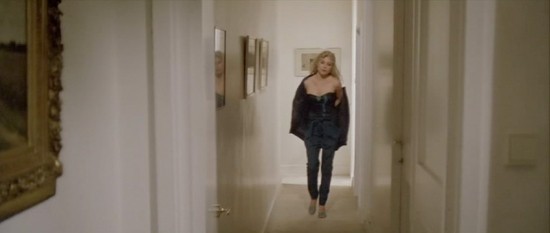
Milena enters Alex’s apartment which is shot to look like a gallery on which walls artworks are carefully colour coordinated in a palette of grey-black to express the sterility of an overly-ordered life. She is wearing a black sleeveless top and tight trousers with a jacket thrown over her arm. She has dressed to fit in, an overt act of self-protective camouflage and adornment. This is a clinical environment in comparison with the warmth and chaos of Milena’s studio home where her clothing is usually a vivid array of clashing colour in an intentional echo of the varied artwork and books lying around amid a calamitous if welcoming and expressive environment. Alex’s art collection is spaced like a carefully chosen display, a conscious reminder of the situation in which we first saw them together, in the title sequence. Now Milena is free to explore the location without his inquisitive watching. She notices an orange file on his desk and makes a note to check it at a later date while the paper in the typewriter platen reveals Alex’s notes about her ex-husband.
Our introduction to Milena at the film’s commencement suggested she was a femme fatale. Her flamboyant mode of dress hinted at a character that was out of control, the opposite of the buttoned-up character whose outward appearance she donned whilst visiting Alex at work. Now we see much more clearly that she is trying on personae for size, trying to fit into different environments following a disastrous early marriage. As the plot progresses it is more obvious that Alex is in fact the film’s homme fatale, causing asymmetric destruction to Milena as he picks apart her behaviour and character, impersonally and clinically as a doctor would a patient prior to informing them of terminal illness and giving them no hope for the future. In her own home her clothes reflect a wilder nature, creating an analogy with the untidy living conditions and carefree character she truly is. It is Alex who tries to alter Milena and her response is self-destruction.
The relationship is over and Alex is following Milena. He spots her emerging from behind a passing tram wearing a purple top and red trousers, her hair tied back in a loose bun. She has escaped.
“Well Doctor – is there any hope for us?”
We are back in happy times, the times that Alex recalled earlier on the bridge, when Milena was physically beneath him, embracing him, clad in red, submitting to him, with a ruby ring on the little finger of her left hand, the Wife Eternal.
Back in Milena’s chaotic home she tries cooking something and is dressed down in a black shantung top over jeans while Alex looks on, hopeless.
Brothers in arms
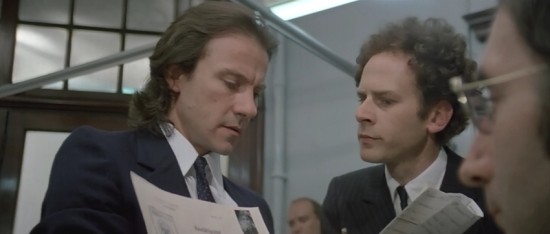
Throughout the film there are constant visual links between Alex and Netusil. Both are investigators, of a sort. They have the same puzzling artworks in their studies although Netusil’s home is a more vulgar Seventies display of homewares and wallpaper; and they are dressed similarly. Garfunkel is serially visually matched with Schiele’s elongated, spare characters and is shot to resemble some of his paintings. Netusil’s happy family life offers stark contrast with Alex’s spare surroundings.
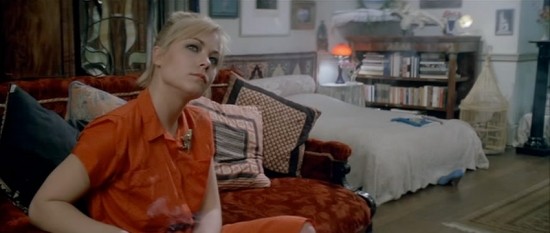
Milena feels obliged to clean up her act for Alex in order to play the role that she perceives he desires. She is wearing a khaki shift in orange which resembles a military uniform, albeit adorned with one of her customary bird brooches. The colour reminds us of the psychological profile he is keeping on her and the style recalls the US Army and the envelope enclosing a letter from her father which led to Alex finding the photograph of her late brother. Her hair is straightened and tied back while the apartment has been spruced up and adorned with an orange Art Déco lamp echoing her outfit, the colour of which is also picked up on the pattern of the elegant chaise where she is poised awaiting Alex’s arrival. Orange is a dominant colour in the threatening undercurrent of the story’s palette and it is the one heralding Alex in his car. Alex is treating her like a case study, not a person. Perhaps he wants to pin her like a butterfly specimen – as though she were one of her own brooches. Now she wants this profile to come to life for him so she can demonstrate that she is not something to be limited to a series of personality tics or labelled as some kind of psychiatric disorder for analysis. The wish fulfilment proves disastrous. He date-rapes her on the staircase.
In Bad Timing, eroticism, fetishism, sexual behaviour, relationships and costume are integrally linked. As Pam Cook states, “the concept of fetishism … traditionally used to condemn fashion and costume for their impurity … can instead be employed to illuminate the ways in which our erotic obsessions with clothes are also transgressive in their play with identity and identification. Identification is another area which has been perceived in a limiting manner by film theory, with consequences for discussion of screen costume” (Cook, 1996: 46). This plaint is echoed slightly differently by Tim Walker, who laments the lack of recognition for costume designers whose work is only recognised come awards season if it is done for period films. It is the very rare occasion on which contemporary costuming is hailed and he declared after the list of costume design nominations for the 2011 Academy Awards in his survey of the preceding decade, “Not to belittle the work of [Colleen] Atwood and her peers, but there’s a glaring lack of any films from beyond the period or fantasy genres. The only contemporary title to earn even a nomination in that time is The Devil Wears Prada – a film about the fashion industry.” (Walker, 2011).
Wild Times
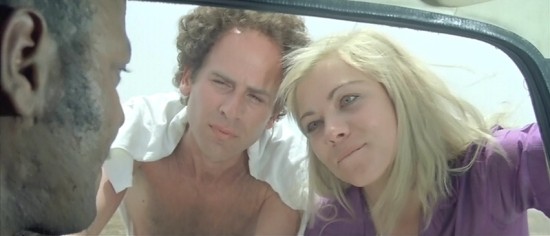
As usual Milena is perfectly at home in her environment, the wildness of Morocco with its snake charmers and oily salesmen, her clothes complementing her serenity in the sunshine, Russell’s somnolent swaying a key to how we perceive her laidback essence. We are reminded of the snake bangles that adorned her wrists earlier in the café when she was cavorting with Konrad.
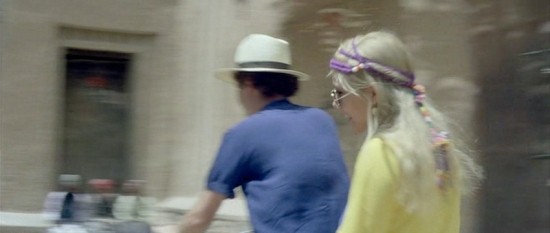
The psychological belief that the colour violet equals violence foretells what will soon come to pass between them. In this still from a very brief scene in the film – she is wearing a native head-dress over her yellow blouse – yellow of course represents sunshine and even hope, although it can also mean jealousy. It emphasises her sense of fitting in wherever she might find herself. Alex is wearing a cooler blue shirt in contrast which ironically reminds us of the dress she herself wore when unwittingly submitting to his profiling of her with the Colour Test.
“What about now?”

Milena resembles a speckled exotic bird, perfectly fitting into the foreign landscape, the pinkness of her earrings and the spots of her pale purple blouse echoing the overwhelming shades of pink dappling the dazzling African light and the buildings snuggling the flat lands. Alex’s domineering attitude fails to undo her good humour. It is indeed in Morocco – what should be their happiest time and place together – the perceptual differences of Milena and Alex are rendered sharply clear in the glaring sunlight. She wants things to stay as they are; he wants them to marry and move to New York. “To be in between is to be nowhere,” he states grimly.
“Where am I going now?”
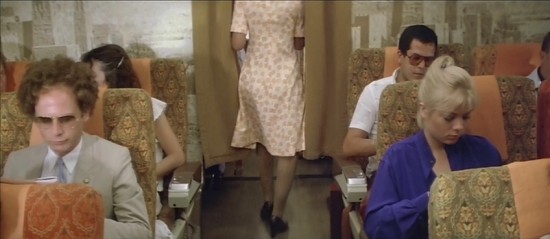
They are clearly separated on the return flight to Vienna. Milena sits across the aisle from Alex wearing the cornflower blue dress she wore earlier when rushing through the Lüscher Colour Test that he bought to aid his psychological profile of her. Now the dress is unbuttoned and she is dressed down and cares less. They are typical Roeg protagonists – strangers in a strange land.
“I wish you’d understand me less and love me more”
“I wish you could stop defining”
Netusil finds the note that Milena has written in desperation to Alex but never given him.
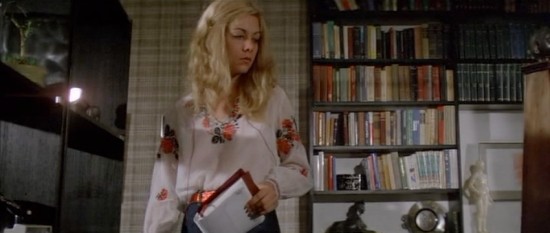
Milena spots the file in Alex’s home study, the orange in her patterned white peasant blouse echoing the colour of the information packaged to represent her existence as a collection of psychiatric tics (Which characterisation is a figment of Alex’s overactive imagination as much as it is an Army-induced act.). The irony of the investigation is that her own father is a retired US Army officer and she is now under the constant vigilance of a voyeur employed by her father’s own employer. The continuum underlying the story’s thread is self-abnegation. Milena lives in the moment; Alex needs to plan strategically based on logic and precedent. His obsession however, leads him to believe that a boy in a photograph is Milena’s lover when in fact he is her dead brother: the truth is just a plain picture but in this film it is always over-analysed, misunderstood and potentially lethal. The date on Alex’s desk diary is March 29th 1979. Russell was just twenty-two years old when the film was made yet gives a veteran’s performance that has rarely been equalled in contemporary cinema. Rumour has it that when she auditioned for the film she turned up in nothing but a fur coat but that cannot be substantiated. She married Nicolas Roeg after production was concluded.
“You’ll never change, Milena. Never.”
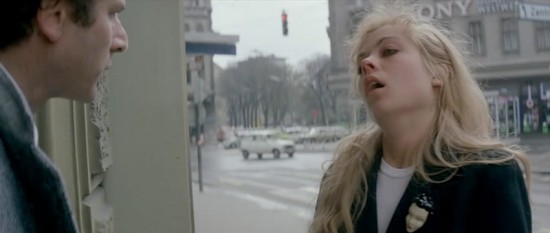
The comedown after Alex and Milena see each other at the University, when she is dressed conservatively in a black jacket and skirt over a white tee-shirt, her only adornment a Pierrot brooch. This is the obverse to her happiest time, when she played ‘patient’ to Alex in the Freud Museum although the costume is similar, but now her hair is undone and her happiness unravels after their encounter. Their roles are now reversed although she is now drunk after visiting his territory once again: the romance is clearly over This is their first meeting after their disastrous African holiday and the ensuing separation.
We cut to a previous drunken encounter when Alex responds to her call and finds her as a Baby Jane-style grotesque with bobbed hair, white pancake face, red bandana, red eye makeup and lips dressed flapper-like in monochrome with a white bra-top over a black jumper. She harries him with the taunting chant, “the death of the Milena you don’t want and the birth of the Milena you do!”
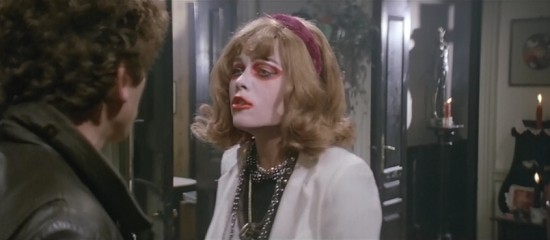
“Who are you?”
We cut forward to Alex watching Milena from a phone booth as she leaves her apartment building on a scooter with her new boyfriend, and they disappear from his view. She is wearing a trench coat (resembling his own), black trousers and shades. The music expresses Alex’s essential dilemma: he has no idea who Milena is.
“Anything to get you back”
In her apartment, where Netusil is with Alex and Stefan at the scene of what Netusil suspects was Milena’s ravishment, Stefan attempts to tell Alex where he went wrong. “You must love a woman tremendously, more even than one’s dignity.” Alex is not capable of it.
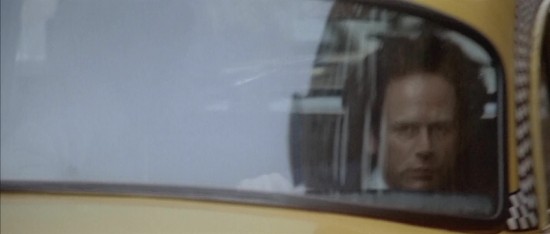
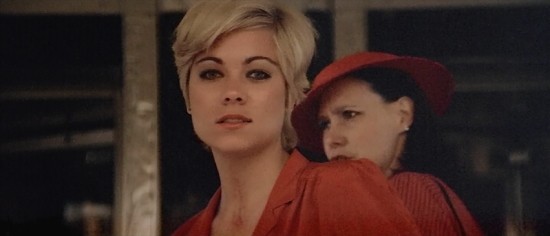
The film’s final sequence, in which Milena is dressed in coral, her airline’s uniform, complementing the yellow New York taxi cab from which Alex spots her and then takes himself after she disembarks, thereby linking her with him and his will to power, still confers on her a perverse independence and non-conformity that sets her apart. She resembles one of her own bird brooches, her neck scarred with the tracheotomy as a serpentine souvenir of their damaging relationship, now moving among her own again, amidst a scene of chattering airline birds wearing her uniformed camouflage, no longer held back, hair shorn like a boy’s, only temporarily alighting on land because her flight has brought her back to ground from the animalistic environment she truly occupies. They have caught a glimpse of what might have been, in the city where Alex wanted to make her a suburban wife, if their polarities could only have been reversed, as he desired.
“How come you’ve been watching me?”
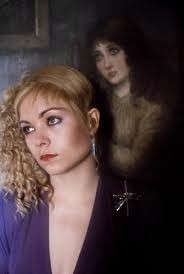
The still to the left is from a scene that was shot but might be reinstated in a fantasy recut director’s version in a parallel universe, perhaps. Milena arrives at a party following her breakup with Alex and creates a scene in front of his cynical lover and a concerned and envious female friend, pulling at his shirt and screaming at him to admit that he wants her. She knows he’s been watching her and noting her movements.
The rainbow of colours to which Marit Allen’s designs refer throughout the diegesis must ultimately hinge on the colour purple – or fuchsia/indigo/violet. In the Freudian world which this narrative inhabits, lateral thinking demands that we make the link between the colour violet and the word violent –a link overtly made in Final Analysis (Joanou, 1992) in which Richard Gere plays analyst to Uma Thurman, analysand, and whose sister (Kim Basinger) bewitches him in a honeytrap. Purple is also the colour of the robe Milena is wearing when unconscious and ravished by Alex; the birdcage symbolising her entrapment is carefully included in the wide shots in that scene-sequence.
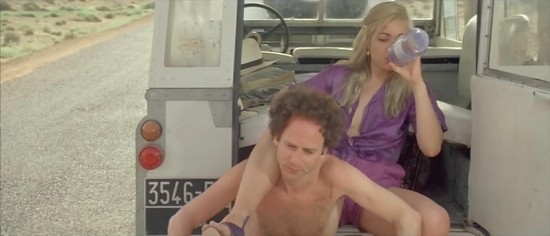
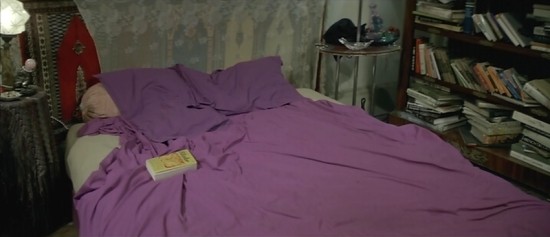
V is for Violent
In this multi-referential still photograph we can see Milena being posed as analogy with the subject of portraiture, much as Madeleine Elster is in Vertigo (Hitchcock, 1958), yet remaining distinctively herself, blonde, decorated and defiant, her brooch as usual connoting an aspect of flight, taking off in several directions at once. Marit Allen’s extraordinary conceptualisation of Milena’s character arc is one of the most exceptional in contemporary cinema, just as Theresa Russell is utterly convincing and ultimately devastating in the role of Milena. This is truly ‘a costume narrative,’ as Sue Harper would have it (Harper, 1994: 30). However the greatest component in the costuming is the texture of Theresa Russell’s luminous flesh and her movement, one of the most underrated elements in analysis of screen acting and yet one of its most subversively affective.
The relationship between a narcissistic voyeuristic psychiatrist and a hedonistic alcoholic nymphomaniac was never going to end well. If Milena is an exotic jungle bird, flaunting her decorative painted feathers in a dance of death, Alex is a bird of prey, whose exploitation of his subject could only ever result in her being pinned in pain by his necromantic fascination, a desire rendered fact in the desperate staircase date-rape and the comatose ravishment. Her scar is a trophy from his scavenger hunt, her survival a measure of her skills. They are forever destined to be out of time.
© Elaine Lennon 2013
Bibliography
Cook, Pam (1996). Fashioning the Nation: Costume and Identity in British Cinema. London: British Film Institute.
Harper, Sue. (1994) Picturing the Past: The Rise and Fall of the Costume Film. London: British Film Institute.
Gibson, Pamela Church (1998). ‘Film Costume’ in The Oxford Guide to Film Studies, eds. John Hill and Pamela Church Gibson. Oxford: Oxford University Press: 36-42.
Laverty, Chris (2011). ‘Clothes on Film. Originally published in Moviescope, Issue 20. Accessed 10 May 2013.
Walker, Tim (2011). ‘The Art of Film Costume Design,’ The Independent, 01 March 2011. Accessed 10 May 2013.

